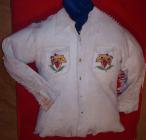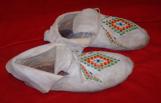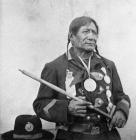2
"Mi'kasto" - Red CrowAbout 1830, at Many Ghosts, the confluence of the St. Mary's and Oldman rivers, home of the Fish Eaters clan of the Kainai band, Mi'kasto (Red Crow) was born, a leader for the ages, a warrior who sought peace, and who spent forty years shepherding his people through the harshest change encountered in centuries.
Though from a long line of chiefs, Red Crow established his own reputation as a warrior and in his youth, participated in 33 raids against the Crow, Cree, Assiniboine, Shoshoni and Nez Percé, killing five enemy warriors. He probably participated in an 1865 retribution attack on a woodcutter's camp in Montana, led by his father-in-law, Calf Shirt-an incident in the Blackfoot Wars. As a warrior, Red Crow claimed to have never been struck by an enemy in battle.
From 1846, until his death in the small pox epidemic of 1869, Piinokoyim (Seen from Afar) was the leader of the Fish Eaters, a powerful status recognized as leader of all the Bloods. Peenaquim's successor, son-in-law Kyiyo-siksinum (Black Bear) had a short reign, also taken by the small pox within weeks. Tradition bestowed that leadership would transfer to Black Bear's son, Red Crow.
Red Crow's sister-Miksiksipoksapowowa (Revenge Walker) married into the whiskey trade of Forts Whoop-Up as the bride of Donald W. Davis. Red Crow bore little hesitance in defending himself from the violence percolated by liquor; his decrees to levy discipline brought death threats. In one attempt, made while asleep, Red Crow pulled a revolver and killed the assailant. Another plot mortally wounded one of his wives, Ohkipiksew (Water Bird).
In 1872, the violence again took hold in a camp near the Highwood River. Kit Fox, the chief's brother, was suspected in having an affair with one of Red Crow's wives. Over a jug of liquor, the discussion put Kit Fox and Red Crow at odds, and the talk turned ugly, and then physical. In the melee, Red Crow struck his brother with a rock, and then lost his temper. In a rage, Kit Fox was hit repeatedly with the stone, until his brother lie dead by the campfire. Red Crow regretted the killing for the rest of his life, but forged his sadness into strong effective leadership.
Red Crow welcomed and co-operated with the North West Mounted Police, and the trust formed was instrumental in the acceptance of Treaty Number Seven between the Canadian government and the Blackfoot peoples. The Bloods expected to subsist on traditional buffalo hunting for another ten years, but by 1879 they were forced into Montana to find game. By 1881, the bison herd depletion the Bloods to return to Canada.
The Blood world changed under the treaty, and Red Crow cannily petitioned the Indian department to grant their Reserve along their traditional Belly and St. Mary's Rivers camping grounds, a reserve comprising over 700 square miles, the largest Aboriginal holding in Canada. The tribe's leaders lent all their encouragement to their people to turn from hunting to farming. By 1884, Red Crow and his family had established a successful vegetable, hay and grain farm, and in time, cattle and horse ranching were introduced to the Reserve.
But the Bloods did not subjugate their spirit. In 1883 a Cree war party stole 45 horses from the reserve, and were fiercely pursued by the owners. The horses were recovered, and at least one of Cree was killed in the melee. The Bloods were not entirely blameless when it came to horse raiding. Several parties made runs into Montana and used the Medicine Line to escape retribution. Fearing that some of his people might be lynched in Montana, Red Crow announced a ban on all trips south of the border, and the tribe's warrior societies enforced the decree.
Reserve life was difficult. Greater contact with newcomers exposed them to new diseases that caused over 700 of the tribe died between 1877 and 1885. Other problems came from government penny pinching that made severe and cruel cuts to the official band rolls, depriving many of entitled rations. Further, Red Crow was angered when agents used an official absence to replace freshly killed beef with bacon in the Treaty ration issues. Agents also tried to circumvent Red Crow's leadership by holding elections to replace him, but he always emerged the victor.
With eruption of the Northwest Rebellion in 1885, emissaries of Louis Riel invited Red Crow and other native leaders to join his armed resistance against the Canadian government. Red Crow had no sympathy with Cree or Métis complaints, but younger Bloods chafed to relive the glories of their elders. In the end, Riel's overtures were rejected and the Blackfoot Confederacy remained neutral.
After the Rebellion, Red Crow faced new realities on the Reserve. He persuaded his people to send their children to residential schools run by the churches in order to learn to read and write. Red Crow saw education as integral to his people's survival. While correct in those aims he never lived to see the many eventual abuses of the residential school system.
Red Crow continued to have problems with the government. He disputed his reserve's southern boundary when Mormon pioneers from Utah settled an area he'd assumed was Blood land. But the old ways of warfare were long gone, and Red Crow became adept at working with the Indian agent. Though not always successful, he urged peaceful solutions, and rarely backed down. In the years of settlement, Red Crow battled with government agents to maintain native spiritual practices and religious freedom on the Reserve.
In August of 1900, after five years of the suppression of the Sun Dance, Red Crow succeeded in the restoration of the annual tradition. He died just days later, August 28, 1900, while herding horses near the Belly River.
3
Red Crow Deer Hide Shirt - "Isttohksisoka'sim"Circa 1890s
Fort Whoop-Up National Historic Site
 Credits:
Credits:Gord Tolton
4
Red Crow Moccasins - "Niitsiitsikiistsi" (original footwear)Circa 1890s
Fort Whoop-Up National Historic Site
 Credits:
Credits:Gord Tolton
5
Red Crow Gauntlets - "Atsi'tsi"Circa 1890s
Fort Whoop-Up National Historic Site
 Credits:
Credits:Quinn Pereverseff
